Workplace Hazard, Safety, and Risk Analysis: A Case Study and Report
VerifiedAdded on 2020/03/16
|10
|2648
|33
Report
AI Summary
This report provides a comprehensive analysis of workplace hazards, safety, and risk management, using a construction accident case study to illustrate key concepts. The introduction defines hazards, risk, and risk assessment, emphasizing their importance in the workplace. The report then examines the breach of safety policies in a specific accident involving a truck driver, Kevin Ragnarok, and the subsequent consequences. It explores the accident's causes, including mechanical failures, and the company's negligence in maintaining vehicles and addressing employee concerns. The report also discusses the legal outcomes and compensation awarded. Furthermore, the report provides insights into preventive measures, such as regular vehicle maintenance and employee training, to avoid similar accidents. It underscores the significance of proactive management, adherence to safety policies, and the importance of employee involvement in identifying and reporting potential hazards. The conclusion reinforces the necessity of a safe work environment and the role of management in ensuring employee safety through effective policies and procedures.
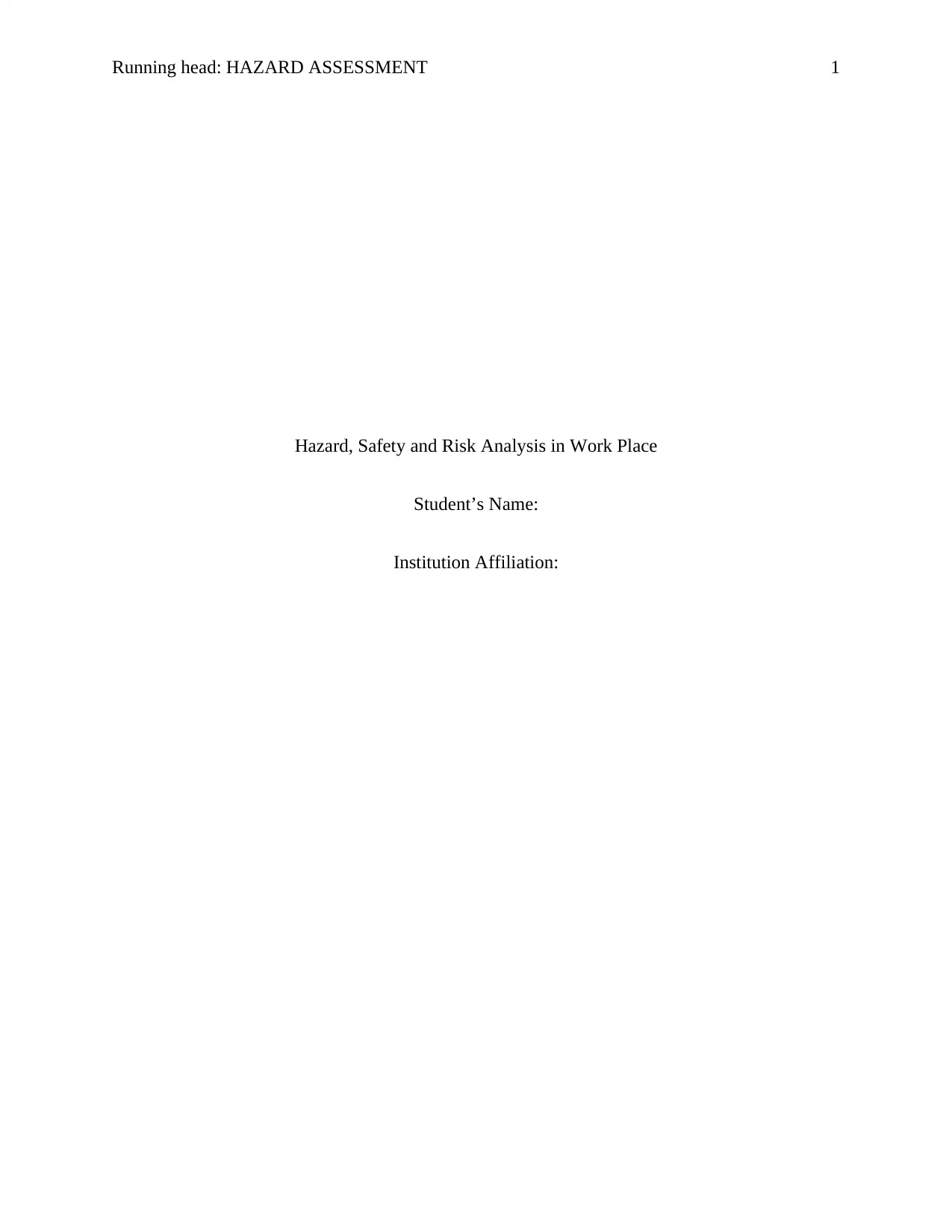
Running head: HAZARD ASSESSMENT 1
Hazard, Safety and Risk Analysis in Work Place
Student’s Name:
Institution Affiliation:
Hazard, Safety and Risk Analysis in Work Place
Student’s Name:
Institution Affiliation:
Paraphrase This Document
Need a fresh take? Get an instant paraphrase of this document with our AI Paraphraser
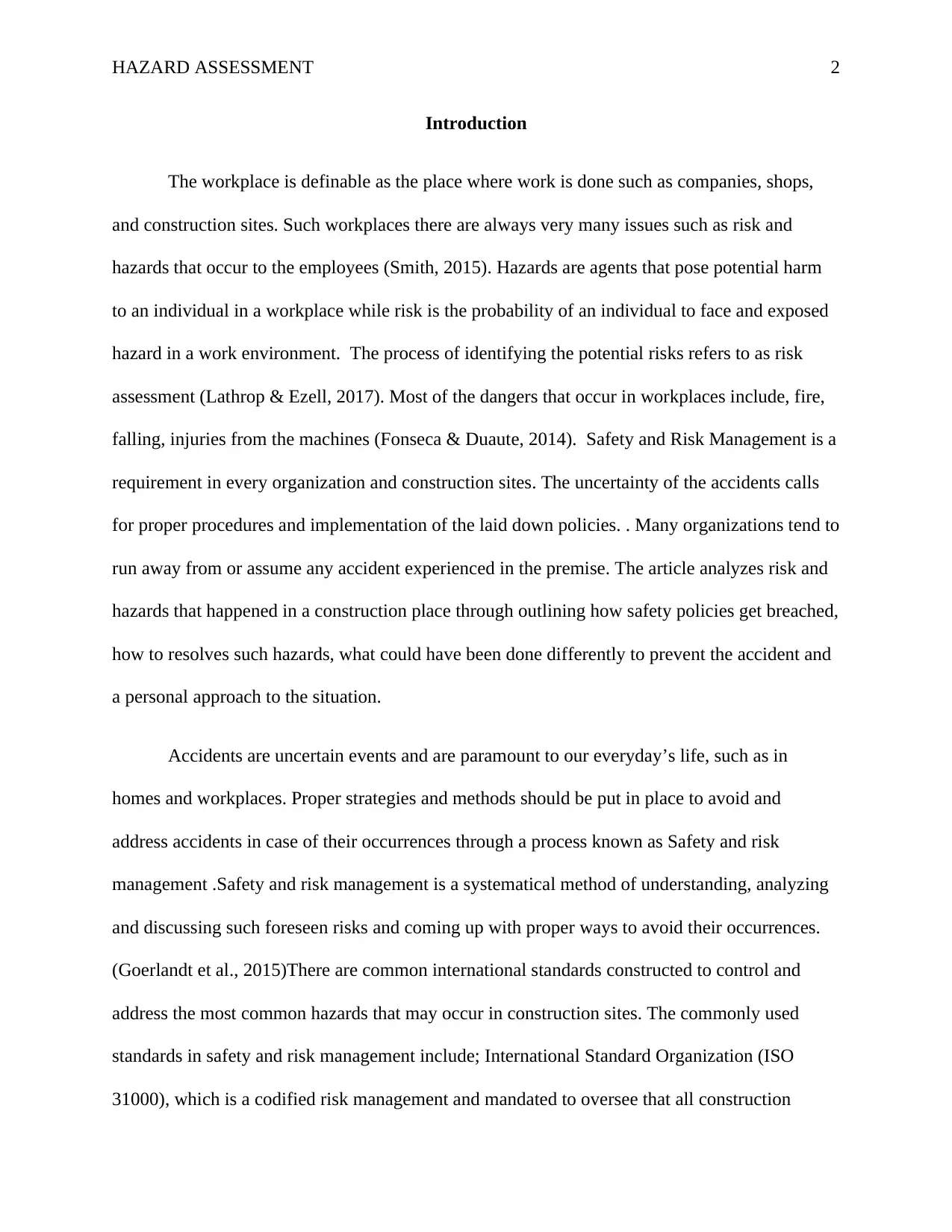
HAZARD ASSESSMENT 2
Introduction
The workplace is definable as the place where work is done such as companies, shops,
and construction sites. Such workplaces there are always very many issues such as risk and
hazards that occur to the employees (Smith, 2015). Hazards are agents that pose potential harm
to an individual in a workplace while risk is the probability of an individual to face and exposed
hazard in a work environment. The process of identifying the potential risks refers to as risk
assessment (Lathrop & Ezell, 2017). Most of the dangers that occur in workplaces include, fire,
falling, injuries from the machines (Fonseca & Duaute, 2014). Safety and Risk Management is a
requirement in every organization and construction sites. The uncertainty of the accidents calls
for proper procedures and implementation of the laid down policies. . Many organizations tend to
run away from or assume any accident experienced in the premise. The article analyzes risk and
hazards that happened in a construction place through outlining how safety policies get breached,
how to resolves such hazards, what could have been done differently to prevent the accident and
a personal approach to the situation.
Accidents are uncertain events and are paramount to our everyday’s life, such as in
homes and workplaces. Proper strategies and methods should be put in place to avoid and
address accidents in case of their occurrences through a process known as Safety and risk
management .Safety and risk management is a systematical method of understanding, analyzing
and discussing such foreseen risks and coming up with proper ways to avoid their occurrences.
(Goerlandt et al., 2015)There are common international standards constructed to control and
address the most common hazards that may occur in construction sites. The commonly used
standards in safety and risk management include; International Standard Organization (ISO
31000), which is a codified risk management and mandated to oversee that all construction
Introduction
The workplace is definable as the place where work is done such as companies, shops,
and construction sites. Such workplaces there are always very many issues such as risk and
hazards that occur to the employees (Smith, 2015). Hazards are agents that pose potential harm
to an individual in a workplace while risk is the probability of an individual to face and exposed
hazard in a work environment. The process of identifying the potential risks refers to as risk
assessment (Lathrop & Ezell, 2017). Most of the dangers that occur in workplaces include, fire,
falling, injuries from the machines (Fonseca & Duaute, 2014). Safety and Risk Management is a
requirement in every organization and construction sites. The uncertainty of the accidents calls
for proper procedures and implementation of the laid down policies. . Many organizations tend to
run away from or assume any accident experienced in the premise. The article analyzes risk and
hazards that happened in a construction place through outlining how safety policies get breached,
how to resolves such hazards, what could have been done differently to prevent the accident and
a personal approach to the situation.
Accidents are uncertain events and are paramount to our everyday’s life, such as in
homes and workplaces. Proper strategies and methods should be put in place to avoid and
address accidents in case of their occurrences through a process known as Safety and risk
management .Safety and risk management is a systematical method of understanding, analyzing
and discussing such foreseen risks and coming up with proper ways to avoid their occurrences.
(Goerlandt et al., 2015)There are common international standards constructed to control and
address the most common hazards that may occur in construction sites. The commonly used
standards in safety and risk management include; International Standard Organization (ISO
31000), which is a codified risk management and mandated to oversee that all construction
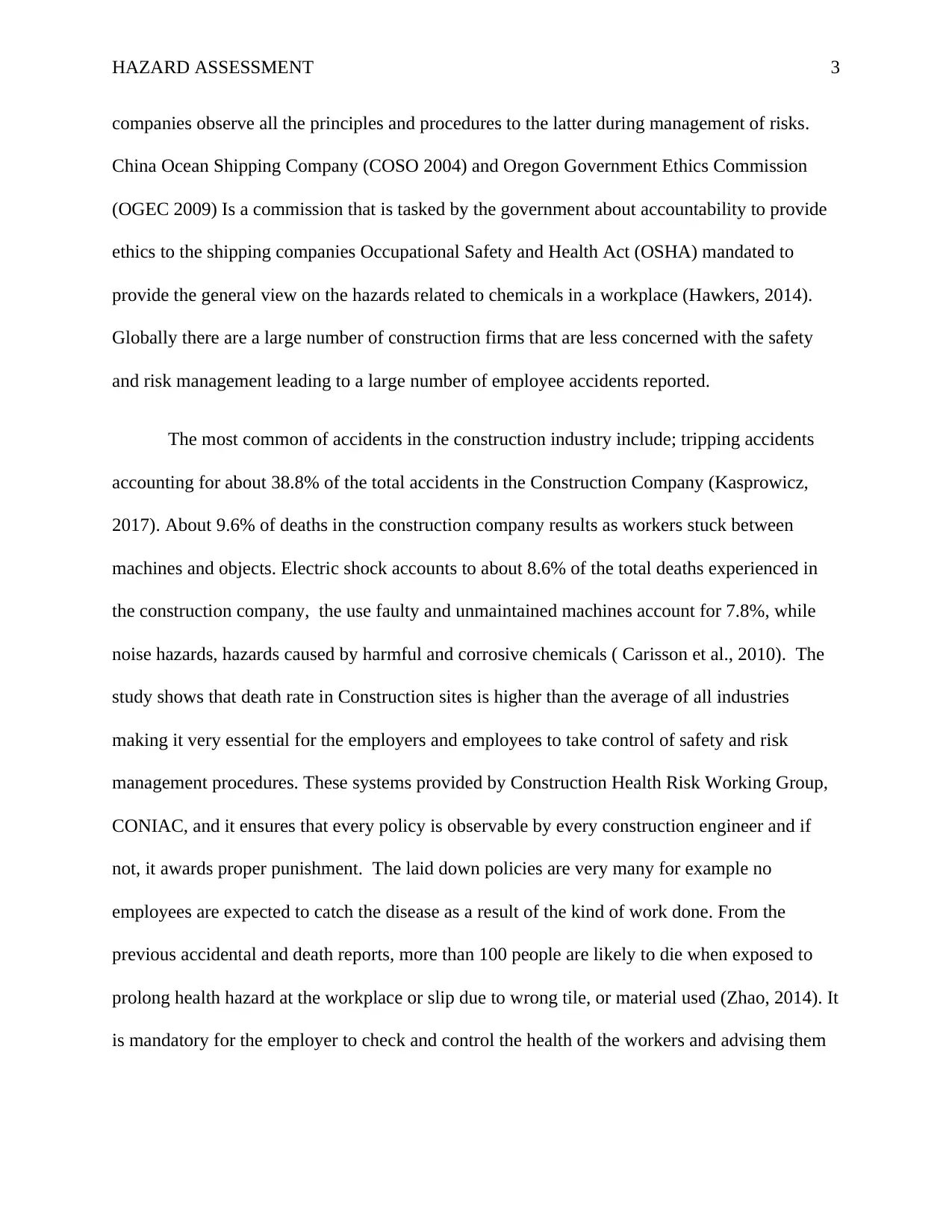
HAZARD ASSESSMENT 3
companies observe all the principles and procedures to the latter during management of risks.
China Ocean Shipping Company (COSO 2004) and Oregon Government Ethics Commission
(OGEC 2009) Is a commission that is tasked by the government about accountability to provide
ethics to the shipping companies Occupational Safety and Health Act (OSHA) mandated to
provide the general view on the hazards related to chemicals in a workplace (Hawkers, 2014).
Globally there are a large number of construction firms that are less concerned with the safety
and risk management leading to a large number of employee accidents reported.
The most common of accidents in the construction industry include; tripping accidents
accounting for about 38.8% of the total accidents in the Construction Company (Kasprowicz,
2017). About 9.6% of deaths in the construction company results as workers stuck between
machines and objects. Electric shock accounts to about 8.6% of the total deaths experienced in
the construction company, the use faulty and unmaintained machines account for 7.8%, while
noise hazards, hazards caused by harmful and corrosive chemicals ( Carisson et al., 2010). The
study shows that death rate in Construction sites is higher than the average of all industries
making it very essential for the employers and employees to take control of safety and risk
management procedures. These systems provided by Construction Health Risk Working Group,
CONIAC, and it ensures that every policy is observable by every construction engineer and if
not, it awards proper punishment. The laid down policies are very many for example no
employees are expected to catch the disease as a result of the kind of work done. From the
previous accidental and death reports, more than 100 people are likely to die when exposed to
prolong health hazard at the workplace or slip due to wrong tile, or material used (Zhao, 2014). It
is mandatory for the employer to check and control the health of the workers and advising them
companies observe all the principles and procedures to the latter during management of risks.
China Ocean Shipping Company (COSO 2004) and Oregon Government Ethics Commission
(OGEC 2009) Is a commission that is tasked by the government about accountability to provide
ethics to the shipping companies Occupational Safety and Health Act (OSHA) mandated to
provide the general view on the hazards related to chemicals in a workplace (Hawkers, 2014).
Globally there are a large number of construction firms that are less concerned with the safety
and risk management leading to a large number of employee accidents reported.
The most common of accidents in the construction industry include; tripping accidents
accounting for about 38.8% of the total accidents in the Construction Company (Kasprowicz,
2017). About 9.6% of deaths in the construction company results as workers stuck between
machines and objects. Electric shock accounts to about 8.6% of the total deaths experienced in
the construction company, the use faulty and unmaintained machines account for 7.8%, while
noise hazards, hazards caused by harmful and corrosive chemicals ( Carisson et al., 2010). The
study shows that death rate in Construction sites is higher than the average of all industries
making it very essential for the employers and employees to take control of safety and risk
management procedures. These systems provided by Construction Health Risk Working Group,
CONIAC, and it ensures that every policy is observable by every construction engineer and if
not, it awards proper punishment. The laid down policies are very many for example no
employees are expected to catch the disease as a result of the kind of work done. From the
previous accidental and death reports, more than 100 people are likely to die when exposed to
prolong health hazard at the workplace or slip due to wrong tile, or material used (Zhao, 2014). It
is mandatory for the employer to check and control the health of the workers and advising them
⊘ This is a preview!⊘
Do you want full access?
Subscribe today to unlock all pages.

Trusted by 1+ million students worldwide
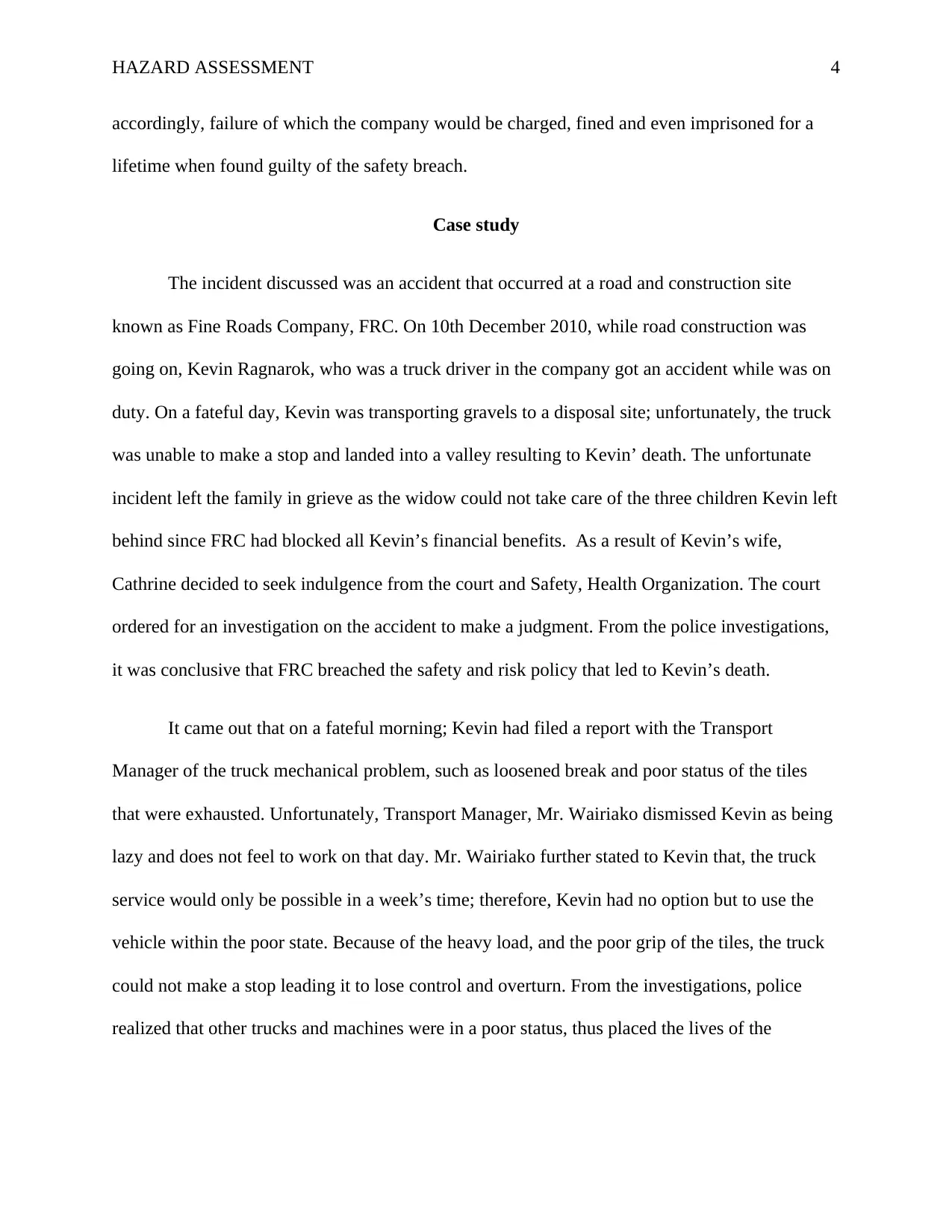
HAZARD ASSESSMENT 4
accordingly, failure of which the company would be charged, fined and even imprisoned for a
lifetime when found guilty of the safety breach.
Case study
The incident discussed was an accident that occurred at a road and construction site
known as Fine Roads Company, FRC. On 10th December 2010, while road construction was
going on, Kevin Ragnarok, who was a truck driver in the company got an accident while was on
duty. On a fateful day, Kevin was transporting gravels to a disposal site; unfortunately, the truck
was unable to make a stop and landed into a valley resulting to Kevin’ death. The unfortunate
incident left the family in grieve as the widow could not take care of the three children Kevin left
behind since FRC had blocked all Kevin’s financial benefits. As a result of Kevin’s wife,
Cathrine decided to seek indulgence from the court and Safety, Health Organization. The court
ordered for an investigation on the accident to make a judgment. From the police investigations,
it was conclusive that FRC breached the safety and risk policy that led to Kevin’s death.
It came out that on a fateful morning; Kevin had filed a report with the Transport
Manager of the truck mechanical problem, such as loosened break and poor status of the tiles
that were exhausted. Unfortunately, Transport Manager, Mr. Wairiako dismissed Kevin as being
lazy and does not feel to work on that day. Mr. Wairiako further stated to Kevin that, the truck
service would only be possible in a week’s time; therefore, Kevin had no option but to use the
vehicle within the poor state. Because of the heavy load, and the poor grip of the tiles, the truck
could not make a stop leading it to lose control and overturn. From the investigations, police
realized that other trucks and machines were in a poor status, thus placed the lives of the
accordingly, failure of which the company would be charged, fined and even imprisoned for a
lifetime when found guilty of the safety breach.
Case study
The incident discussed was an accident that occurred at a road and construction site
known as Fine Roads Company, FRC. On 10th December 2010, while road construction was
going on, Kevin Ragnarok, who was a truck driver in the company got an accident while was on
duty. On a fateful day, Kevin was transporting gravels to a disposal site; unfortunately, the truck
was unable to make a stop and landed into a valley resulting to Kevin’ death. The unfortunate
incident left the family in grieve as the widow could not take care of the three children Kevin left
behind since FRC had blocked all Kevin’s financial benefits. As a result of Kevin’s wife,
Cathrine decided to seek indulgence from the court and Safety, Health Organization. The court
ordered for an investigation on the accident to make a judgment. From the police investigations,
it was conclusive that FRC breached the safety and risk policy that led to Kevin’s death.
It came out that on a fateful morning; Kevin had filed a report with the Transport
Manager of the truck mechanical problem, such as loosened break and poor status of the tiles
that were exhausted. Unfortunately, Transport Manager, Mr. Wairiako dismissed Kevin as being
lazy and does not feel to work on that day. Mr. Wairiako further stated to Kevin that, the truck
service would only be possible in a week’s time; therefore, Kevin had no option but to use the
vehicle within the poor state. Because of the heavy load, and the poor grip of the tiles, the truck
could not make a stop leading it to lose control and overturn. From the investigations, police
realized that other trucks and machines were in a poor status, thus placed the lives of the
Paraphrase This Document
Need a fresh take? Get an instant paraphrase of this document with our AI Paraphraser
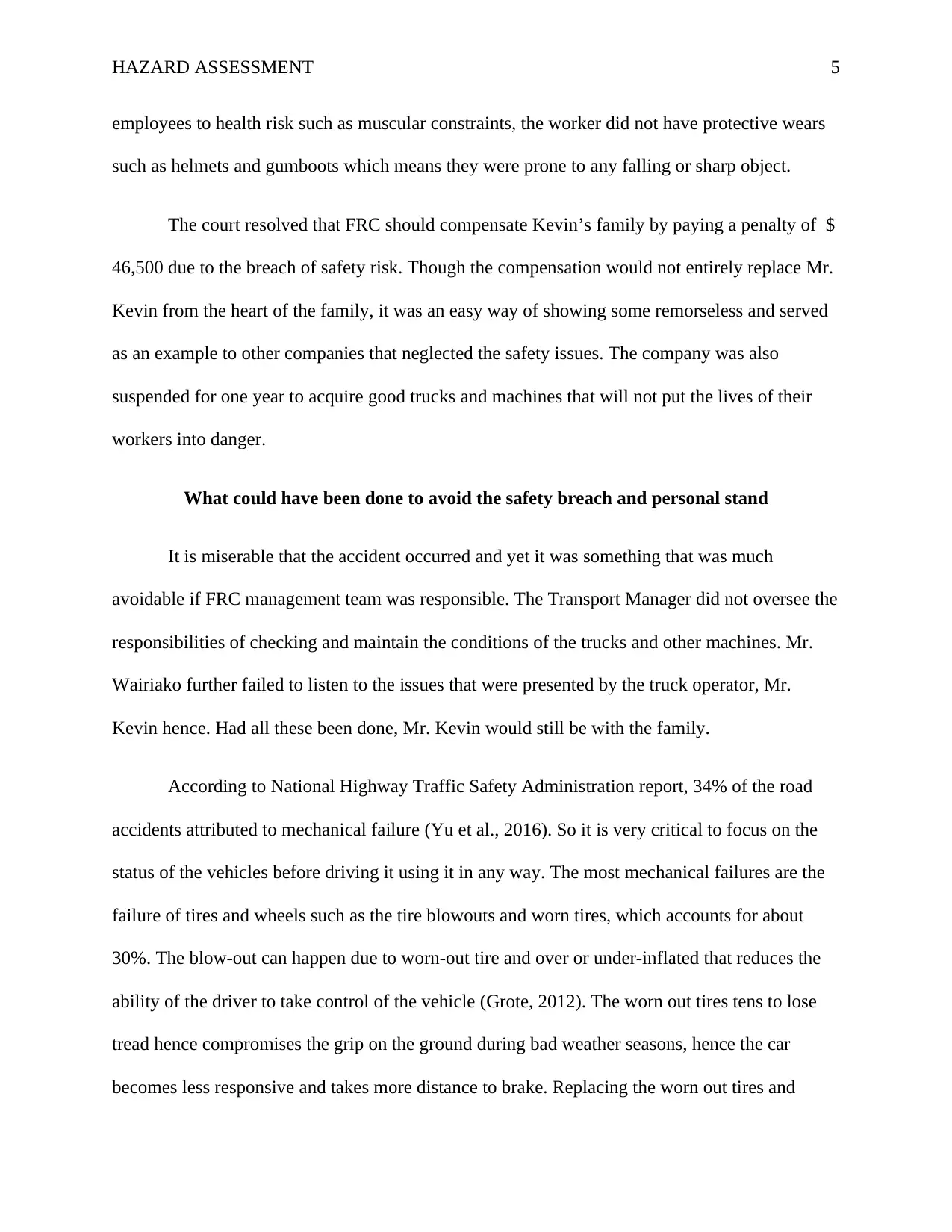
HAZARD ASSESSMENT 5
employees to health risk such as muscular constraints, the worker did not have protective wears
such as helmets and gumboots which means they were prone to any falling or sharp object.
The court resolved that FRC should compensate Kevin’s family by paying a penalty of $
46,500 due to the breach of safety risk. Though the compensation would not entirely replace Mr.
Kevin from the heart of the family, it was an easy way of showing some remorseless and served
as an example to other companies that neglected the safety issues. The company was also
suspended for one year to acquire good trucks and machines that will not put the lives of their
workers into danger.
What could have been done to avoid the safety breach and personal stand
It is miserable that the accident occurred and yet it was something that was much
avoidable if FRC management team was responsible. The Transport Manager did not oversee the
responsibilities of checking and maintain the conditions of the trucks and other machines. Mr.
Wairiako further failed to listen to the issues that were presented by the truck operator, Mr.
Kevin hence. Had all these been done, Mr. Kevin would still be with the family.
According to National Highway Traffic Safety Administration report, 34% of the road
accidents attributed to mechanical failure (Yu et al., 2016). So it is very critical to focus on the
status of the vehicles before driving it using it in any way. The most mechanical failures are the
failure of tires and wheels such as the tire blowouts and worn tires, which accounts for about
30%. The blow-out can happen due to worn-out tire and over or under-inflated that reduces the
ability of the driver to take control of the vehicle (Grote, 2012). The worn out tires tens to lose
tread hence compromises the grip on the ground during bad weather seasons, hence the car
becomes less responsive and takes more distance to brake. Replacing the worn out tires and
employees to health risk such as muscular constraints, the worker did not have protective wears
such as helmets and gumboots which means they were prone to any falling or sharp object.
The court resolved that FRC should compensate Kevin’s family by paying a penalty of $
46,500 due to the breach of safety risk. Though the compensation would not entirely replace Mr.
Kevin from the heart of the family, it was an easy way of showing some remorseless and served
as an example to other companies that neglected the safety issues. The company was also
suspended for one year to acquire good trucks and machines that will not put the lives of their
workers into danger.
What could have been done to avoid the safety breach and personal stand
It is miserable that the accident occurred and yet it was something that was much
avoidable if FRC management team was responsible. The Transport Manager did not oversee the
responsibilities of checking and maintain the conditions of the trucks and other machines. Mr.
Wairiako further failed to listen to the issues that were presented by the truck operator, Mr.
Kevin hence. Had all these been done, Mr. Kevin would still be with the family.
According to National Highway Traffic Safety Administration report, 34% of the road
accidents attributed to mechanical failure (Yu et al., 2016). So it is very critical to focus on the
status of the vehicles before driving it using it in any way. The most mechanical failures are the
failure of tires and wheels such as the tire blowouts and worn tires, which accounts for about
30%. The blow-out can happen due to worn-out tire and over or under-inflated that reduces the
ability of the driver to take control of the vehicle (Grote, 2012). The worn out tires tens to lose
tread hence compromises the grip on the ground during bad weather seasons, hence the car
becomes less responsive and takes more distance to brake. Replacing the worn out tires and
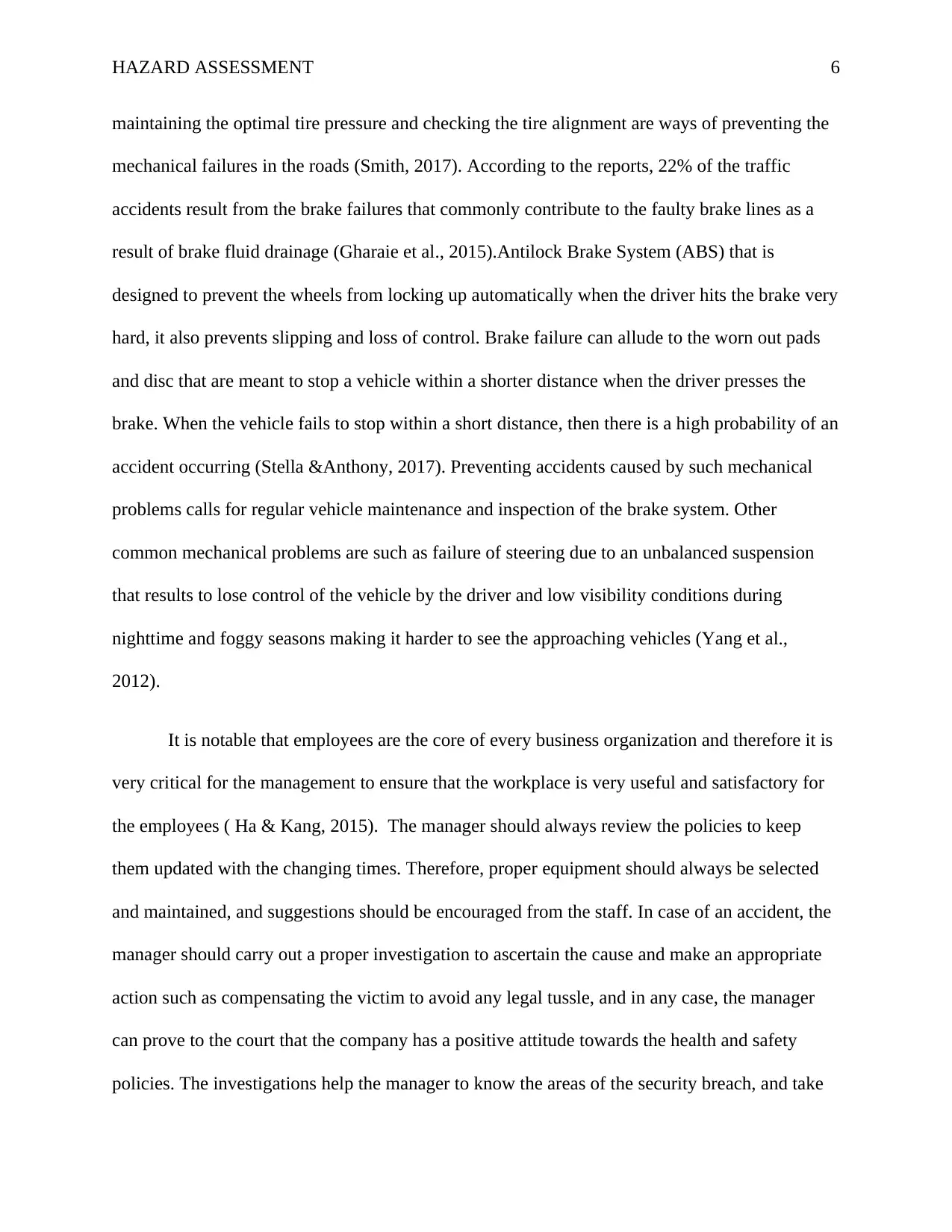
HAZARD ASSESSMENT 6
maintaining the optimal tire pressure and checking the tire alignment are ways of preventing the
mechanical failures in the roads (Smith, 2017). According to the reports, 22% of the traffic
accidents result from the brake failures that commonly contribute to the faulty brake lines as a
result of brake fluid drainage (Gharaie et al., 2015).Antilock Brake System (ABS) that is
designed to prevent the wheels from locking up automatically when the driver hits the brake very
hard, it also prevents slipping and loss of control. Brake failure can allude to the worn out pads
and disc that are meant to stop a vehicle within a shorter distance when the driver presses the
brake. When the vehicle fails to stop within a short distance, then there is a high probability of an
accident occurring (Stella &Anthony, 2017). Preventing accidents caused by such mechanical
problems calls for regular vehicle maintenance and inspection of the brake system. Other
common mechanical problems are such as failure of steering due to an unbalanced suspension
that results to lose control of the vehicle by the driver and low visibility conditions during
nighttime and foggy seasons making it harder to see the approaching vehicles (Yang et al.,
2012).
It is notable that employees are the core of every business organization and therefore it is
very critical for the management to ensure that the workplace is very useful and satisfactory for
the employees ( Ha & Kang, 2015). The manager should always review the policies to keep
them updated with the changing times. Therefore, proper equipment should always be selected
and maintained, and suggestions should be encouraged from the staff. In case of an accident, the
manager should carry out a proper investigation to ascertain the cause and make an appropriate
action such as compensating the victim to avoid any legal tussle, and in any case, the manager
can prove to the court that the company has a positive attitude towards the health and safety
policies. The investigations help the manager to know the areas of the security breach, and take
maintaining the optimal tire pressure and checking the tire alignment are ways of preventing the
mechanical failures in the roads (Smith, 2017). According to the reports, 22% of the traffic
accidents result from the brake failures that commonly contribute to the faulty brake lines as a
result of brake fluid drainage (Gharaie et al., 2015).Antilock Brake System (ABS) that is
designed to prevent the wheels from locking up automatically when the driver hits the brake very
hard, it also prevents slipping and loss of control. Brake failure can allude to the worn out pads
and disc that are meant to stop a vehicle within a shorter distance when the driver presses the
brake. When the vehicle fails to stop within a short distance, then there is a high probability of an
accident occurring (Stella &Anthony, 2017). Preventing accidents caused by such mechanical
problems calls for regular vehicle maintenance and inspection of the brake system. Other
common mechanical problems are such as failure of steering due to an unbalanced suspension
that results to lose control of the vehicle by the driver and low visibility conditions during
nighttime and foggy seasons making it harder to see the approaching vehicles (Yang et al.,
2012).
It is notable that employees are the core of every business organization and therefore it is
very critical for the management to ensure that the workplace is very useful and satisfactory for
the employees ( Ha & Kang, 2015). The manager should always review the policies to keep
them updated with the changing times. Therefore, proper equipment should always be selected
and maintained, and suggestions should be encouraged from the staff. In case of an accident, the
manager should carry out a proper investigation to ascertain the cause and make an appropriate
action such as compensating the victim to avoid any legal tussle, and in any case, the manager
can prove to the court that the company has a positive attitude towards the health and safety
policies. The investigations help the manager to know the areas of the security breach, and take
⊘ This is a preview!⊘
Do you want full access?
Subscribe today to unlock all pages.

Trusted by 1+ million students worldwide
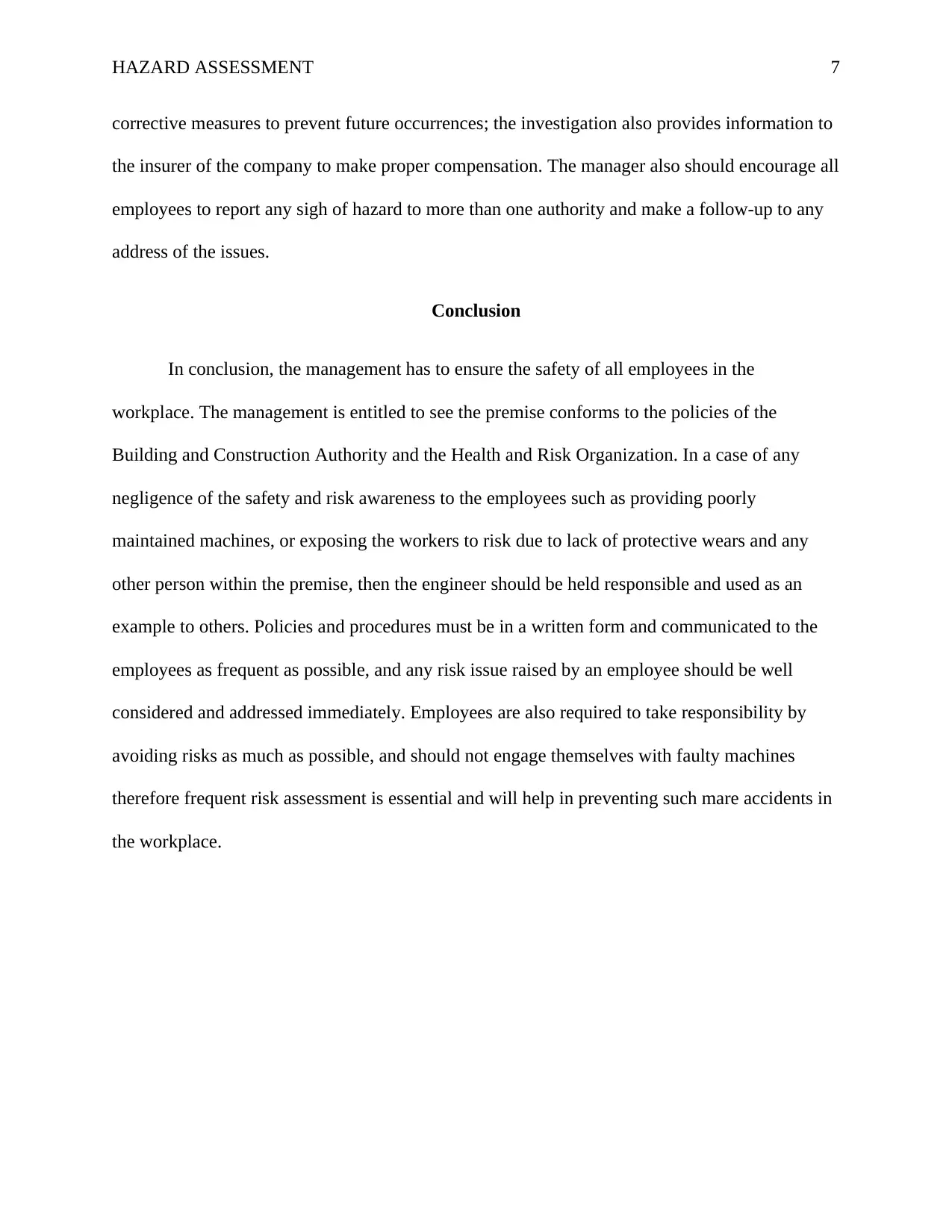
HAZARD ASSESSMENT 7
corrective measures to prevent future occurrences; the investigation also provides information to
the insurer of the company to make proper compensation. The manager also should encourage all
employees to report any sigh of hazard to more than one authority and make a follow-up to any
address of the issues.
Conclusion
In conclusion, the management has to ensure the safety of all employees in the
workplace. The management is entitled to see the premise conforms to the policies of the
Building and Construction Authority and the Health and Risk Organization. In a case of any
negligence of the safety and risk awareness to the employees such as providing poorly
maintained machines, or exposing the workers to risk due to lack of protective wears and any
other person within the premise, then the engineer should be held responsible and used as an
example to others. Policies and procedures must be in a written form and communicated to the
employees as frequent as possible, and any risk issue raised by an employee should be well
considered and addressed immediately. Employees are also required to take responsibility by
avoiding risks as much as possible, and should not engage themselves with faulty machines
therefore frequent risk assessment is essential and will help in preventing such mare accidents in
the workplace.
corrective measures to prevent future occurrences; the investigation also provides information to
the insurer of the company to make proper compensation. The manager also should encourage all
employees to report any sigh of hazard to more than one authority and make a follow-up to any
address of the issues.
Conclusion
In conclusion, the management has to ensure the safety of all employees in the
workplace. The management is entitled to see the premise conforms to the policies of the
Building and Construction Authority and the Health and Risk Organization. In a case of any
negligence of the safety and risk awareness to the employees such as providing poorly
maintained machines, or exposing the workers to risk due to lack of protective wears and any
other person within the premise, then the engineer should be held responsible and used as an
example to others. Policies and procedures must be in a written form and communicated to the
employees as frequent as possible, and any risk issue raised by an employee should be well
considered and addressed immediately. Employees are also required to take responsibility by
avoiding risks as much as possible, and should not engage themselves with faulty machines
therefore frequent risk assessment is essential and will help in preventing such mare accidents in
the workplace.
Paraphrase This Document
Need a fresh take? Get an instant paraphrase of this document with our AI Paraphraser
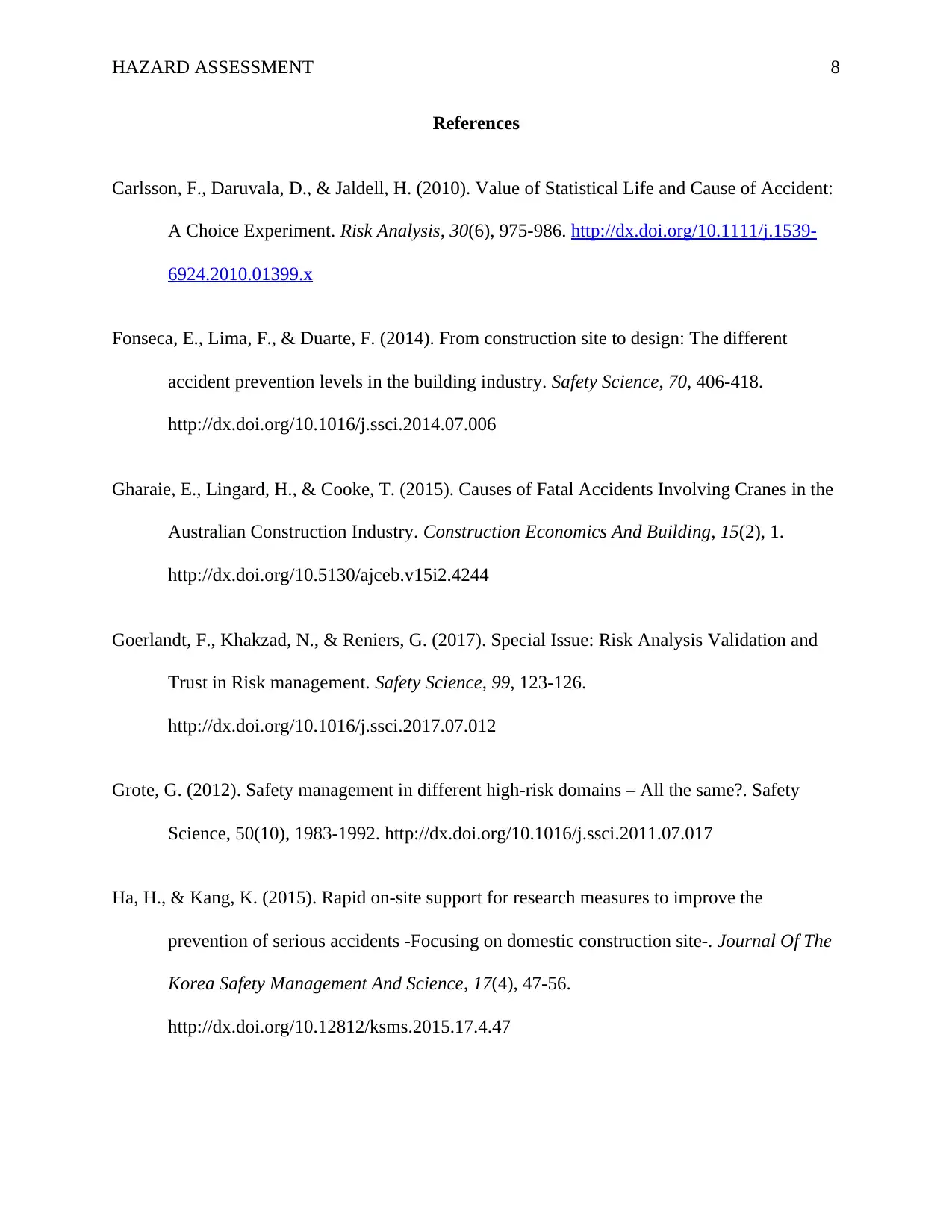
HAZARD ASSESSMENT 8
References
Carlsson, F., Daruvala, D., & Jaldell, H. (2010). Value of Statistical Life and Cause of Accident:
A Choice Experiment. Risk Analysis, 30(6), 975-986. http://dx.doi.org/10.1111/j.1539-
6924.2010.01399.x
Fonseca, E., Lima, F., & Duarte, F. (2014). From construction site to design: The different
accident prevention levels in the building industry. Safety Science, 70, 406-418.
http://dx.doi.org/10.1016/j.ssci.2014.07.006
Gharaie, E., Lingard, H., & Cooke, T. (2015). Causes of Fatal Accidents Involving Cranes in the
Australian Construction Industry. Construction Economics And Building, 15(2), 1.
http://dx.doi.org/10.5130/ajceb.v15i2.4244
Goerlandt, F., Khakzad, N., & Reniers, G. (2017). Special Issue: Risk Analysis Validation and
Trust in Risk management. Safety Science, 99, 123-126.
http://dx.doi.org/10.1016/j.ssci.2017.07.012
Grote, G. (2012). Safety management in different high-risk domains – All the same?. Safety
Science, 50(10), 1983-1992. http://dx.doi.org/10.1016/j.ssci.2011.07.017
Ha, H., & Kang, K. (2015). Rapid on-site support for research measures to improve the
prevention of serious accidents -Focusing on domestic construction site-. Journal Of The
Korea Safety Management And Science, 17(4), 47-56.
http://dx.doi.org/10.12812/ksms.2015.17.4.47
References
Carlsson, F., Daruvala, D., & Jaldell, H. (2010). Value of Statistical Life and Cause of Accident:
A Choice Experiment. Risk Analysis, 30(6), 975-986. http://dx.doi.org/10.1111/j.1539-
6924.2010.01399.x
Fonseca, E., Lima, F., & Duarte, F. (2014). From construction site to design: The different
accident prevention levels in the building industry. Safety Science, 70, 406-418.
http://dx.doi.org/10.1016/j.ssci.2014.07.006
Gharaie, E., Lingard, H., & Cooke, T. (2015). Causes of Fatal Accidents Involving Cranes in the
Australian Construction Industry. Construction Economics And Building, 15(2), 1.
http://dx.doi.org/10.5130/ajceb.v15i2.4244
Goerlandt, F., Khakzad, N., & Reniers, G. (2017). Special Issue: Risk Analysis Validation and
Trust in Risk management. Safety Science, 99, 123-126.
http://dx.doi.org/10.1016/j.ssci.2017.07.012
Grote, G. (2012). Safety management in different high-risk domains – All the same?. Safety
Science, 50(10), 1983-1992. http://dx.doi.org/10.1016/j.ssci.2011.07.017
Ha, H., & Kang, K. (2015). Rapid on-site support for research measures to improve the
prevention of serious accidents -Focusing on domestic construction site-. Journal Of The
Korea Safety Management And Science, 17(4), 47-56.
http://dx.doi.org/10.12812/ksms.2015.17.4.47
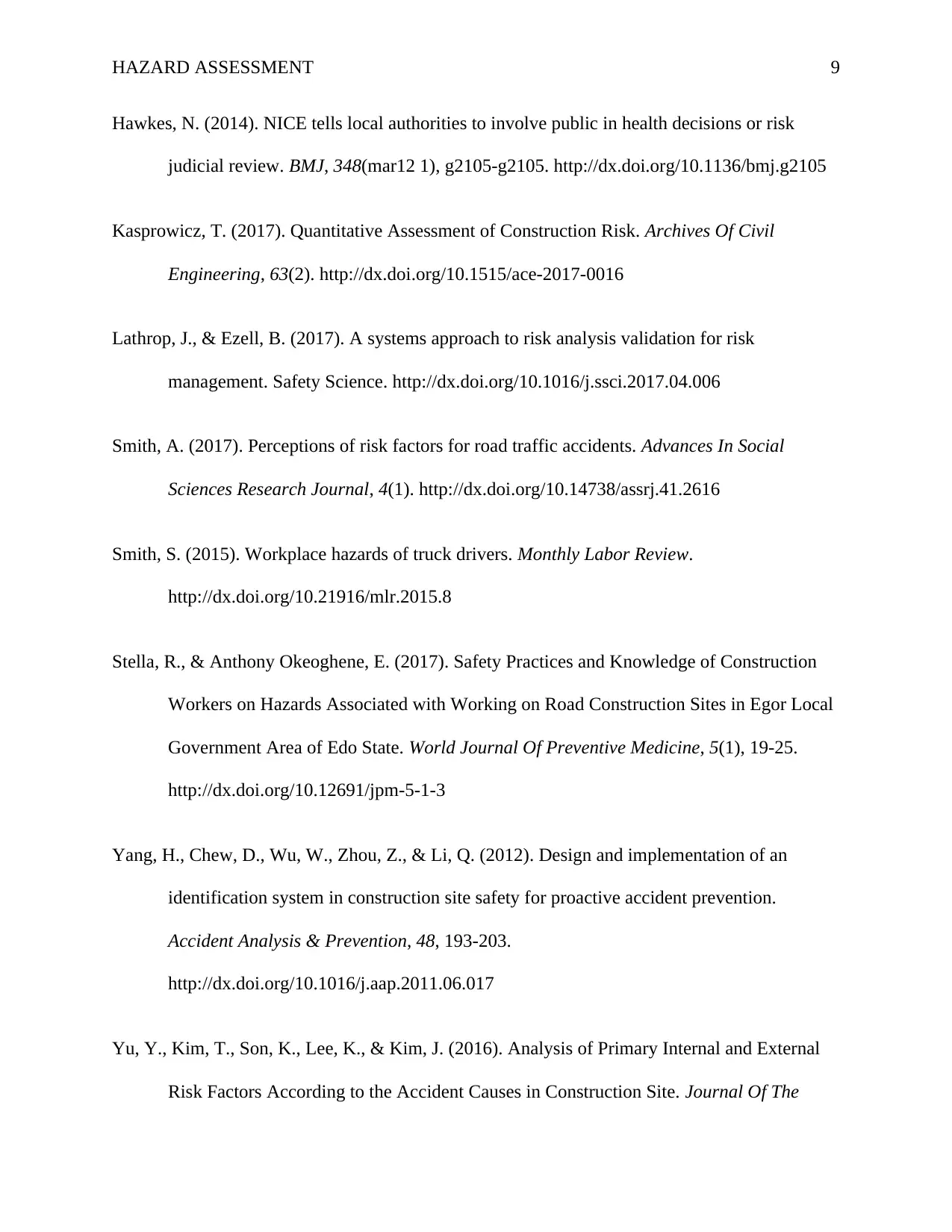
HAZARD ASSESSMENT 9
Hawkes, N. (2014). NICE tells local authorities to involve public in health decisions or risk
judicial review. BMJ, 348(mar12 1), g2105-g2105. http://dx.doi.org/10.1136/bmj.g2105
Kasprowicz, T. (2017). Quantitative Assessment of Construction Risk. Archives Of Civil
Engineering, 63(2). http://dx.doi.org/10.1515/ace-2017-0016
Lathrop, J., & Ezell, B. (2017). A systems approach to risk analysis validation for risk
management. Safety Science. http://dx.doi.org/10.1016/j.ssci.2017.04.006
Smith, A. (2017). Perceptions of risk factors for road traffic accidents. Advances In Social
Sciences Research Journal, 4(1). http://dx.doi.org/10.14738/assrj.41.2616
Smith, S. (2015). Workplace hazards of truck drivers. Monthly Labor Review.
http://dx.doi.org/10.21916/mlr.2015.8
Stella, R., & Anthony Okeoghene, E. (2017). Safety Practices and Knowledge of Construction
Workers on Hazards Associated with Working on Road Construction Sites in Egor Local
Government Area of Edo State. World Journal Of Preventive Medicine, 5(1), 19-25.
http://dx.doi.org/10.12691/jpm-5-1-3
Yang, H., Chew, D., Wu, W., Zhou, Z., & Li, Q. (2012). Design and implementation of an
identification system in construction site safety for proactive accident prevention.
Accident Analysis & Prevention, 48, 193-203.
http://dx.doi.org/10.1016/j.aap.2011.06.017
Yu, Y., Kim, T., Son, K., Lee, K., & Kim, J. (2016). Analysis of Primary Internal and External
Risk Factors According to the Accident Causes in Construction Site. Journal Of The
Hawkes, N. (2014). NICE tells local authorities to involve public in health decisions or risk
judicial review. BMJ, 348(mar12 1), g2105-g2105. http://dx.doi.org/10.1136/bmj.g2105
Kasprowicz, T. (2017). Quantitative Assessment of Construction Risk. Archives Of Civil
Engineering, 63(2). http://dx.doi.org/10.1515/ace-2017-0016
Lathrop, J., & Ezell, B. (2017). A systems approach to risk analysis validation for risk
management. Safety Science. http://dx.doi.org/10.1016/j.ssci.2017.04.006
Smith, A. (2017). Perceptions of risk factors for road traffic accidents. Advances In Social
Sciences Research Journal, 4(1). http://dx.doi.org/10.14738/assrj.41.2616
Smith, S. (2015). Workplace hazards of truck drivers. Monthly Labor Review.
http://dx.doi.org/10.21916/mlr.2015.8
Stella, R., & Anthony Okeoghene, E. (2017). Safety Practices and Knowledge of Construction
Workers on Hazards Associated with Working on Road Construction Sites in Egor Local
Government Area of Edo State. World Journal Of Preventive Medicine, 5(1), 19-25.
http://dx.doi.org/10.12691/jpm-5-1-3
Yang, H., Chew, D., Wu, W., Zhou, Z., & Li, Q. (2012). Design and implementation of an
identification system in construction site safety for proactive accident prevention.
Accident Analysis & Prevention, 48, 193-203.
http://dx.doi.org/10.1016/j.aap.2011.06.017
Yu, Y., Kim, T., Son, K., Lee, K., & Kim, J. (2016). Analysis of Primary Internal and External
Risk Factors According to the Accident Causes in Construction Site. Journal Of The
⊘ This is a preview!⊘
Do you want full access?
Subscribe today to unlock all pages.

Trusted by 1+ million students worldwide
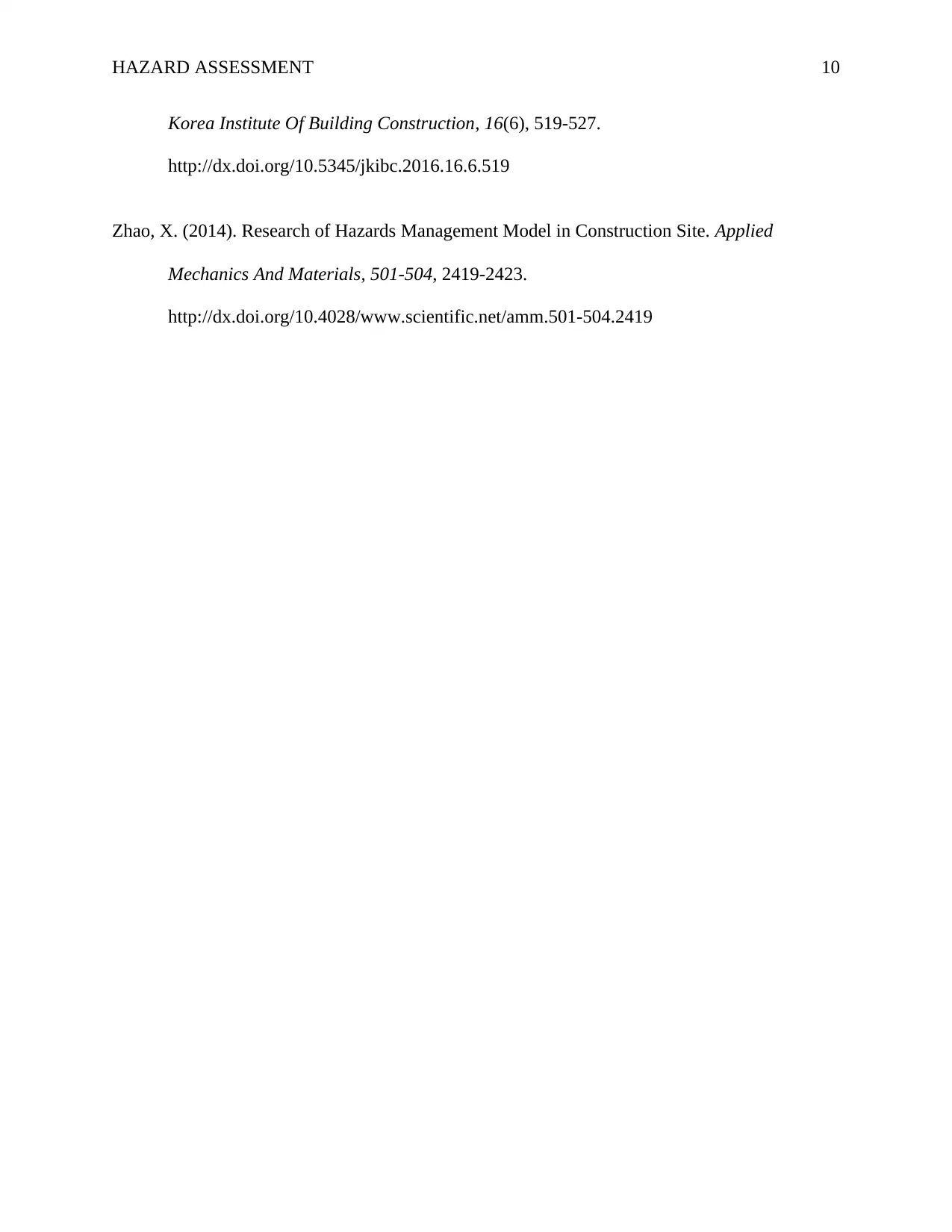
HAZARD ASSESSMENT 10
Korea Institute Of Building Construction, 16(6), 519-527.
http://dx.doi.org/10.5345/jkibc.2016.16.6.519
Zhao, X. (2014). Research of Hazards Management Model in Construction Site. Applied
Mechanics And Materials, 501-504, 2419-2423.
http://dx.doi.org/10.4028/www.scientific.net/amm.501-504.2419
Korea Institute Of Building Construction, 16(6), 519-527.
http://dx.doi.org/10.5345/jkibc.2016.16.6.519
Zhao, X. (2014). Research of Hazards Management Model in Construction Site. Applied
Mechanics And Materials, 501-504, 2419-2423.
http://dx.doi.org/10.4028/www.scientific.net/amm.501-504.2419
1 out of 10
Related Documents
Your All-in-One AI-Powered Toolkit for Academic Success.
+13062052269
info@desklib.com
Available 24*7 on WhatsApp / Email
![[object Object]](/_next/static/media/star-bottom.7253800d.svg)
Unlock your academic potential
Copyright © 2020–2025 A2Z Services. All Rights Reserved. Developed and managed by ZUCOL.




